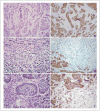Heterogeneity of breast cancer metastases: comparison of therapeutic target expression and promoter methylation between primary tumors and their multifocal metastases
- PMID: 18381931
- PMCID: PMC2965068
- DOI: 10.1158/1078-0432.CCR-07-4082
Heterogeneity of breast cancer metastases: comparison of therapeutic target expression and promoter methylation between primary tumors and their multifocal metastases
Abstract
Purpose: A comprehensive comparison of biomarker expression between patients' primary breast carcinoma (PBC) and their metastatic breast carcinomas (MBC) has not been done.
Experimental design: We did rapid autopsies (postmortem intervals, 1-4 hours) on 10 consenting patients who died of MBC. We constructed single-patient tissue microarrays from the patients' archived PBC and multiple different MBCs harvested at autopsy, which were immunohistochemically labeled for multiple biomarkers. Methylation of multiple gene promoters was assessed quantitatively on dissected PBC and MBC samples.
Results: Extensive heterogeneity was observed between PBC and their paired MBC, as well as among multiple MBC from the same patient. Estrogen and progesterone receptors tended to be uniformly down-regulated in metastases. E-cadherin was down-regulated in a subset of the MBC of one case. Variable overexpression in MBC compared with the PBC was observed for cyclooxygenase-2 (five cases), epidermal growth factor receptor (EGFR; four cases), MET (four cases), and mesothelin (four cases). No case strongly overexpressed HER-2/neu by immunohistochemistry, but eight cases showed variable protein expression ranging from negative to equivocal (2+) in different MBC. In one case, variable low-level HER-2/neu gene amplification was found. EGFR and MET overexpression were restricted to the four basal-type cancers. EGFR protein overexpression did not correlate with EGFR gene amplification. Multigene promoter hypermethylation of RASSF1a, HIN1, cyclin D2, Twist, estrogen receptor alpha, APC1, and RARbeta was overall very similar in the PBC and all MBCs in all cases.
Conclusions: Therapeutic targets identified in the PBC or even some MBC may not reflect targets present in all metastatic sites.
Figures




Comment in
-
Comparisons of metastases in different organs: biological and clinical implications.Clin Cancer Res. 2008 Apr 1;14(7):1923-5. doi: 10.1158/1078-0432.CCR-07-5259. Clin Cancer Res. 2008. PMID: 18381928 Review. No abstract available.
References
Publication types
MeSH terms
Substances
Grants and funding
LinkOut - more resources
Full Text Sources
Other Literature Sources
Medical
Research Materials
Miscellaneous

